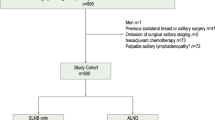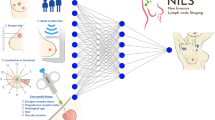Abstract
The expression of tumour promoter gene S100A4, metastasis suppressor gene nm23, oestrogen and progesterone receptors, and tumour grade and size have been investigated for their potential to predict breast cancer progression. The molecular and cellular data have been analysed using artificial neural networks to determine the potential of these markers to predict the presence of metastatic tumour in the regional lymph nodes. This study shows that tumour grade and size are poor predictors. The relative expression of S100A4 and nm23 genes is the single most effective predictor of nodal status. Inclusion of oestrogen- and progesterone-receptor status with tumour grade and size markers improves prediction; however, there may be some overlap between steroid receptors and molecular markers. This study also underscores the power of artificial neural network techniques to predict the potential of primary breast cancers to spread to axillary lymph nodes. This could aid the clinician in determining whether invasive procedures of axially node dissection can be obviated and whether conservative forms of treatment might be appropriate in the management of the patient.
Similar content being viewed by others
References
Fisher B, Ravdin RG, Ausman RK et al. Surgical adjuvant chemotherapy in cancer of the breast: Results of a decade cooperative investigation. Ann Surg 1996; 168: 337–56.
Galea MH, Blamey RW, Elston CE, Ellis IO. The Nottingham prognostic index in primary breast cancer. Breast Cancer Res Treat 1992; 22: 207–19.
Sherbet GV, Parker C, Usmani BA, Lakshmi MS. Epidermal growth factor receptor status correlates with cell proliferation-related 18A2/mts1 gene expression in human carcinoma cell lines. Ann NY Acad Sci 1995; 768: 272–6.
Parker C, Whittaker PA, Usmani B et al. Induction of 18A2/mts1 gene expression and its effects on metastasis and cell cycle control.DNA Cell Biol 1994; 13: 1021–8.
Lloyd BH, Platt-Higgins A, Rudland PS et al. Human S100A4 (p9Ka) induces the metastatic phenotype upon benign tumour cells. Oncogene1998; 17, 465–73.
Sherbet GV. Calcium Signalling in Cancer: The Role of Calcium Binding Proteins in Cell Proliferation, Invasion and Metastasis. Boca Raton Florida: CRC Press2001.
Rosengard AM, Krutsch HC, Shearn A et al. Reduced nm23/awd protein in tumour metastasis and aberrant rosophila development. Nature 1989; 342: 177–80.
Steeg PS, Leone A, Rosengard A et al. A novel gene nm23 is associated with low tumour metastatic potential. Clin Exp Metastasis 1990;8: (Suppl 1): 16.
Stahl JA, Leone A, Rosengard AM et al. Identification of a second human nm23 gene, nm23-H2. Cancer Res 1991; 51: 445–9
Sherbet GV, Lakshmi MS. The Genetics of Cancer. London/New York: Academic Press 1997.
Royds JA, Stephenson TJ, Rees RC et al. Nm23 protein expression in ductal in situ and invasive human breast carcinoma. J Natl Cancer Inst 1993; 85: 727–31.
Hennessy C, Henry JA, May FEB et al. Expression of the antimetastatic gene nm23 in human breast cancer: An association with good prognosis. J Natl Cancer Inst 1991;83: 281–5.
Tokunaga Y, Urano T, Furakawa K et al. Reduced expression of nm23-H1, but not of nm23-H2, is concordant with the frequency of lymph node metastasis of breast cancer. Int J Cancer 1993; 55: 66–71.
Charpin C, Garcia S, Bonnier P et al. Prognostic significance of nm23/NDPK expression in breast carcinoma assessed on 10-year follow-up by automated and quantitative immunocytochemical assays.J Pathol 1998;184: 401–7.
Albertazzi E, Cajone F, Leone BE et al. The expression of metastasis associated genes mts1 and nm23 in carcinoma of the breast are related to disease progression. DNA Cell Biol1998; 17: 335–42.
Chariot A, Castronovo V. Detection of HOX-A1 expression in human breast cancer. Biochem Biophys Res Commun 1996; 222: 292–7.
Phippard DJ, Weber-Hall SJ, Sharpe PT et al. Regulation of Msx-1, Msx-2, Bmp-2, and Bmp-4 during foetal a postnatal mammary gland development. Development1996;122: 2729–37.
Piva R, Rimondi AP, Hanau S et al. Different methylation of oestrogen receptor DNA in human breast carcinomas with and without oestrogen receptor. Br J Cancer 1990; 61: 270–5.
Falette NS, Fuqua SA, Chamness GC et al. Oestrogen receptor gene methylation in human breast tumours. Cancer Res 1990; 50: 3874–978.
Ottaviano YL, Issa JJ, Parl FF et al. Methylation of the oestrogen receptor gene CpG island marks loss of oestrogen receptor expression in human breast cancer cells. Cancer Res 1994; 54: 2552–5.
Lapidus RG, Ferguson AT, Ottaviano YL et al. Methylation of oestrogen and progesterone receptor gene 5′ CpG islands correlates with lack of oestrogen and progesterone receptor gene expression in breast tumours. Clin Cancer Res 1996; 2: 805–10.
Piva R, Kumar VL, Hanau S et al. Abnormal methylation of oestrogen receptor gene and reduced oestrogen receptor RNA levels in human endometrial carcinomas. J Steroid Biochem Mol Biol1989; 32: 1–4.
Issa JJ, Ottaviano YL, Celano P et al. Methylation of the oestrogen receptor CpG island links ageing and neoplasia in human colon. Nature Genet 1994; 7: 536–40.
Issa JJ, Zehnbauer BA, Civin CI et al. The oestrogen receptor CpG island is methylated in most haematopoietic neoplasms. Cancer Res 1996; 56: 973–7.
Issa JJ, Baylin SB, Belinsky SA. Methylation of oestrogen receptor CpG island in lung cancer is related to the specific types of carcinogen exposure. Cancer Res 1998; 56: 3655–8.
Li LC, Chui K, Nakajima K et al. Frequent methylation of oestrogen receptor in prostate cancer. Correlation with tumour progression. Cancer Res 2000; 60: 702–6.
Seker H, Odetayo M, Petrovic D et al. Afuzzy measurement-based assessment of breast cancer prognostic markers. Proc IEEE EMBS Int Conf Information Tech Appl Med 2000; 174–8.
Seker H, Odetayo M, Petrovic D et al. Assessment of nodal involvement and survival analysis in breast cancer patients using image cytometric data: statistical, neural and fuzzy approaches. Anticancer Res 2002; 22: 433–8.
Gurney K. An Introduction to Neural Networks. London: UCL Press1997.
Chen WY, Liao YF, Chen SH. Speech recognition with hierarchical recurrent neural networks. Pattern Recog 1995; 28: 795–805.
Rodin EY, Wu Y, Amin SM. Character recognition: qualitative reasoning and neural networks. Math Computer Modelling 1992;16: 95–104.
Huang SN, Tan KK, Lee TH. Adaptive motion control using neural network approximations. Automatica 2002; 38: 227–33.
Zhenqing L, Mingda L, Moan W. Structure noise reduction of ultrasonic signals using artificial neural network adaptive filtering. Ultrasonics 1997; 35: 325–8.
Khandetsky V, Antonyuk I. Signal processing in defect detection using back-propagation neural networks. NDT & E Int 2002; 35: 483–8.
Olmez T, Dokur Z. Classification of heart sounds using an artificial neural network. Pattern Recog Lett 2003; 24: 617–29.
Hornik K, Stinchcombe M, White H. Multilayer feedforward networks are universal approximators. Neural Networks 1989; 2: 359–66.
Rafiq MY, Bugmann G, Easterbrook DJ. Neural network design for engineering applications. Comput Struct 2001; 79: 1541–52.
Bishop CM. Neural Networks for Pattern Recognition. Oxford: Oxford University Press 1995.
Chua B, Ung O, Taylor R et al. Frequency and predictors of axillary lymph nodes metastases in invasive breast cancer. Anz J Surg 2001; 71: 723–8.
Hawkins RA, Roberts MM, Forrest APM. Oestrogen receptors and breast cancer: Current status. Br J Surg 1980; 67: 153–69.
Hawkins RA, Teasdale AL, Prescott RJ et al. Outcome after extended follow-up in a prospective study of operable breast cancer: Key factors and a prognostic index. Br J Cancer 2002; 87: 8–14.
Rayter Z. Steroid receptors in breast cancer. Br J Surg 1991; 78: 528–35.
Williams MR, Todd JH, Ellis IO et al. Estrogen receptors in primary and advanced breast cancer: An eight year review of 704 cases. Br J Cancer 1987; 55: 67–73.
Clark GM, McGuire WI, Hubay CA et al. Progesterone receptors as a prognostic factor in stage II breast cancer. N Engl J Med 1983; 309: 1343–7.
Thorpe SM, Rose C, Rasmussen BB et al. Prognostic value of steroid hormone receptors: Multivariate analysis of systemically untreated patients with node negative primary breast cancer. Cancer Res 1987; 47: 6126–33.
Mason BH, Holdaway IM, Mullins PR et al. Progesterone and oestrogen receptors as prognostic variables in breast cancer. Cancer Res 1983; 43: 2985–90.
Chevallier B, Heintzmann F, Mosseri V et al. Prognostic value of estrogen and progesterone receptors in operable breast cancer-results of a univariate and multivariate analysis. Cancer 1988; 62: 2517–24.
Platt-Higgins AM, Renshaw CA, West CR et al. Comparison of the metastasis-inducing protein S100A4 (p9Ka) with other prognostic markers in human breast cancer. Int J Cancer 2000; 89: 198–208.
Andronas M, Dlay SS, Sherbet GV. Oestrogen and progesterone receptor expression influences DNA ploidy and the proliferation potential of breast cancer cells. Anticancer Res2003; 23: 3031–42.
Lin KH, Wang WG, Wu YH, Cheng SY. Activation of anti-metastatic nm23-H1 gene expression by oestrogen and its alpha receptor. Endocrinology 2002; 143: 467–75.
Author information
Authors and Affiliations
Corresponding author
Rights and permissions
About this article
Cite this article
Grey, S., Dlay, S., Leone, B. et al. Prediction of nodal spread of breast cancer by using artificial neural network-based analyses of S100A4, nm23 and steroid receptor expression. Clin Exp Metastasis 20, 507–514 (2003). https://doi.org/10.1023/A:1025846019656
Issue Date:
DOI: https://doi.org/10.1023/A:1025846019656




